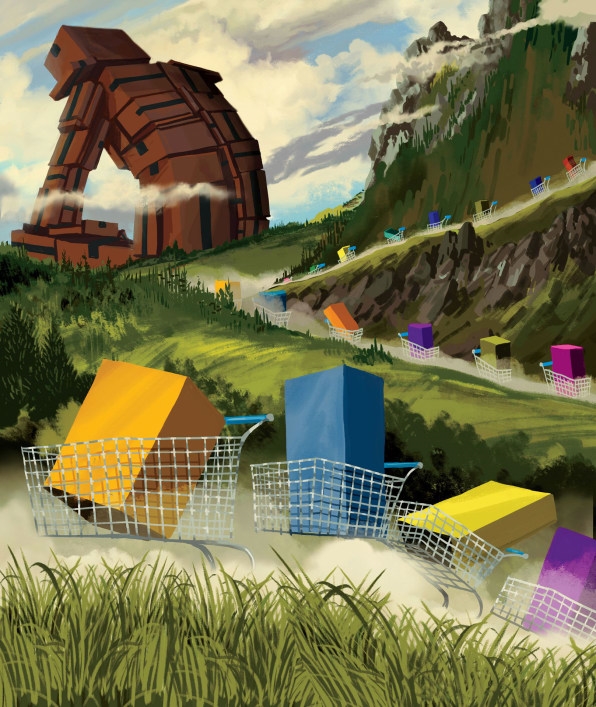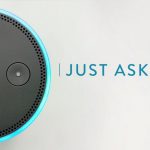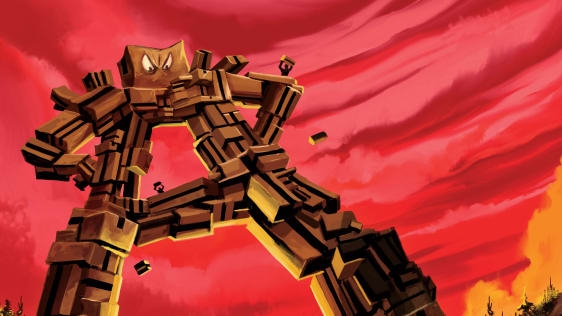The Future Of Retail In The Age Of Amazon
The Mall of America’s terrazzo floors, glazed white like doughnut frosting, ribbon out in every direction, creating a vast mirror maze of consumerism with 520 glassy storefronts. Shoppers, who have escaped an endlessly gray Bloomington, Minnesota, sky on a Monday morning in October, drift through the largest mall in the United States like tourists at an Atlantic City buffet. A couple holding hands strolls into a Zales while buttery perfumes emanate from an Auntie Anne’s next door. Kids and some willing parents fling around on the SpongeBob SquarePants Rock Bottom Plunge roller coaster, one of 27 rides at the Nickelodeon-branded amusement park on-site. Distant echoes of saxophone Muzak clash with both elevator whirs and bubbly pop songs. Somewhere in this otherworldly commercial expanse are five Lids stores and four Sunglass Huts.
When the mall opened, in 1992, it represented the pinnacle of retail convenience and a mecca for young people to gather and spend. But the $650 million megamall was always “vaguely unreal . . . exuding the ambience of a monstrous hallucination,” as novelist David Guterson described it in a 1993 Harper’s article, calling it “monolithic and imposing.” Two years later, Jeff Bezos launched his online book marketplace, which quickly grew into a new type of Everything Store, one that fundamentally redefined the shopping experience and led some to argue that commercial centers like the Mall of America would become gaudy relics of an antiquated era.
Now, Wall Street analysts say, the retail apocalypse is upon us. Amazon dominates e-commerce and has gobbled up 5% of total U.S. retail sales. Some expect that the company will own half the online market within the next five years, a period during which, Credit Suisse predicts, a quarter of all malls will close. By the end of this year, more than 8,600 stores will have shuttered in 2017, the worst year on record.
But here’s the thing about the Mall of America: It’s fighting back. “I hear all this doom and gloom in the industry,” says the mall’s SVP of business development, Jill Renslow, with an upbeat, Midwestern delivery. “I’m like, ‘Folks! Keep your chin up! There’s so much opportunity!’?” The mall completed a $325 million expansion in 2015, says Renslow, who started working there as an intern in the mid-1990s and has seen it endure recessions and upheaval before. A new 342-room JW Marriott has opened upstairs, and retailers like Zara and Anthropologie are being lured to the space. The mall is experimenting with new leasing models to attract pop-ups and younger players like Untuckit and Toms Shoes. Renslow, who is eager for people coming to Minneapolis for the 2018 Super Bowl this February to visit the mall and be surprised, doesn’t view Amazon as a competitor but as a partner; she recently worked with Amazon to install a set of pickup lockers at the mall. She believes retailers in general can “bring online shoppers to brick-and-mortar.” I ask her directly: Is physical retail dying? “Not at all!” she says.
Renslow isn’t feigning enthusiasm. Despite Wall Street’s pessimism, industry leaders sound downright bullish on the future of traditional retail. Why else, they argue, would Amazon spend $13.4 billion to buy Whole Foods? Sure, the competition is fiercer than ever, and icons such as Sears and JCPenney are dying. But they believe that the narrative has been oversimplified. “Amazon alone isn’t holding the knife,” says NYU Stern professor of marketing Scott Galloway, who studies the retail industry. Cultural tastes have changed. Malls grew too quickly, at twice the rate of the population, from 1970 to 2015. Many retailers succumbed to quarterly earnings pressures, invested in share buybacks rather than their stores, became saddled with private-equity debt, or failed to keep pace with digital trends. What we’re seeing now, industry executives say, is a rational, albeit painful, course correction. One study from retail-research firm IHL Group found that a mere 16 chains, including RadioShack and Payless, account for nearly half of all store closings, and that there will be a net increase of more than 4,000 stores in 2017 and 5,500-plus in 2018.
“Retail is under huge pressure, but the death of stores is greatly exaggerated,” says Galloway, who believes that while Amazon will continue to disrupt the market, an increasing number of competitors will discover new ways to respond. “In the age of Amazon, retailers must leverage assets that [Bezos] doesn’t have: When Amazon zigs, retailers must zag.”
This fall, Fast Company embarked on a journey to learn from those retailers that are flourishing in the age of Amazon. After all, more than 90% of retail sales still happen in the real world, and as relentless as Bezos is, it’s not likely he’ll swallow up all of brick-and-mortar on his own. The truth is that the bigger Amazon gets, the more opportunity it creates for fresh, local alternatives. The more Amazon pushes robot-powered efficiency, the more space there is for warm and individualized service. The more that people interact with Amazon through its AI-based assistant Alexa, the more they will crave the insight and personal connection of fellow humans.
“The idea that everybody needs to be terrified of Amazon is completely wrong,” says Brian Spaly, who cofounded two e-commerce-centric startups, Bonobos (menswear) and Trunk Club (a wardrobe-in-a-box service), which sold to Walmart and Nordstrom, respectively, for nine-figure sums. “Everybody needs to figure out what makes them special and use those weapons to compete.”

Successful Retailers Will Feature Products That Customers Can’t Get Elsewhere
A 15-minute drive north from the Mall of America are the downtown Minneapolis headquarters of Target. The company’s $7 billion bet on its future is coming to life in a series of spacious rooms littered across several floors and filled with mannequins, racks of colorful apparel, and fashion magazines. It’s here that Target is designing its own goods, refocusing on the aesthetic sensibility that fueled its success in the early 2000s. “While others are shrinking their footprints, reducing head count, or trying to save their way to the next quarter, we think there’s opportunity for us to take more market share,” says CEO Brian Cornell, who launched the initiative last February.
On the fourth floor, at the studio for Cat & Jack, Target’s new children’s clothing line—which blew up in its first 12 months to become a $2.1 billion brand—mood boards display photos of smiling tots at a July Fourth block party and a family movie night. Julie Guggemos, Target’s SVP of product development, describes the spirit behind the design as “positivity, happiness, saving the world,” citing the adventurous tweens in Netflix’s Stranger Things as an inspiration for the team. “We listen to Mom and Dad, but we have these kids in mind when we’re designing,” says Guggemos, a 27-year Target veteran.
Guggemos and her team of 400-plus designers will be rolling out more than a dozen high-quality, affordable, Target-exclusive brands by the end of 2018. They have already introduced a boutiquey children’s decor line called Pillowfort, a modern furniture collection called Project 62, an athleisure apparel line for the post-yoga brunch crowd called JoyLab, and a dapper menswear brand called Goodfellow & Co, which even Esquire described as “elevated.” Guggemos has just come from a product review for a new line, slated to launch next year. “We’re designing everything from the bottom up, 100% original,” she says.
When consumers can get seemingly anything and everything online, what can Target offer that Amazon can’t? That question was top of mind for chief merchandising officer Mark Tritton when he joined the company from Nordstrom in 2016. Target had fallen into a trap of licensing outside brands like Cherokee, which makes children’s apparel; even its in-house kids’ label, Circo, felt dated. “I thought, Wow, this stuff isn’t right,” recalls Tritton. “It feels tired and disconnected.”
In other words, Target had strayed from what made it “Tar-zhay.” Two decades ago, the company had distinguished itself from other big-box retailers by teaming up with celebrated architect and designer Michael Graves to craft a collection of mass-market housewares, partnering with high-end fashion designers like Isaac Mizrahi for custom fashion lines, and nurturing emerging brands such as Method through forward-thinking curation. “There would be no retail if it weren’t for merchandising, so why isn’t anyone talking about it anymore?” wonders Rachel Shechtman, founder of Story, the novel Manhattan concept store, which reinvents itself regularly (and collaborated with Target in 2014). “Merch assortments designed by spreadsheets and algorithms” is what’s killing department stores, she says.
When I meet Target COO John Mulligan at Target’s flagship, which sits just a block away from the Cat & Jack studio, he’s eager to compare the store’s $10 million renovation with printed-out photos of the old layout, which hadn’t changed much since the flagship was built in 2001. “It was gondola hell, right?” Mulligan says, referring to the basic shelving units you see in stores. “Just rows and rows of stuff. No sight lines.” Mulligan shakes his head as he points to a depressing image of the in-store Pizza Hut that used to greet customers.
The layout has been reorganized around Target’s new brands, and the presentation is crisp and contemporary. (Inexplicably, the company didn’t have a visual merchandising department until just two years ago; Cornell has since poached talent from J.Crew and the Limited.) As Mulligan ushers me through the store, he beams at the displays, each of which will now be refreshed monthly, which is double the previous rate: There’s an autumn-themed collection from Cat & Jack; sporty JoyLab leggings designed in partnership with Clique, whose Who What Wear line has been a hit at Target since it launched in 2016; and modern dining chairs and walnut tables from Project 62. “Before, it was a dead zone back here,” he says of the home-essentials area. Other parts of the store feature bright new arrangements of exclusive products from e-commerce upstarts such as Harry’s and Casper, and even the fitting room looks more like what you’d find in a Club Monaco. As for the Hut? It’s been replaced by fresh groceries and a liquor and craft beer shop. Target will remodel an additional 1,000 stores in a similar fashion by 2020, while also rolling out more localized stores with smaller footprints.
The redesigned “Tar-zhays”—there are around 110 of them so far—have delivered up to a 4% jump in sales at each location, but the more promising return from this investment has come from the house brands themselves. Cat & Jack customers, for example, spend 50% more in surrounding kids’ retail areas, Mulligan says, adding that their total basket size is 23% higher than other customers’. Most significantly, Target’s consumer research has shown that its brands have become a “trip driver”: People come to the store for Cat & Jack as much as they do for essentials like laundry detergent or bread or milk. “Target has always won with a spirit of design that their competitors didn’t have. I don’t see any other move for them: They’re not going to beat Amazon on e-commerce,” says a high-level retail expert who has advised the company on strategy.
Indeed, Target’s digital efforts continue to lag. When Mulligan takes me to the back to show off the redesigned storeroom, I don’t see any floor-roaming robots or automated conveyer belts, despite the fact that Target has stated that it plans to use its more than 1,800 stores as fulfillment centers (80% of the U.S. population lives within 10 miles of a Target). Instead, I find just one store clerk manually taping cardboard boxes for in-store pickup. Later, when I arrive to retrieve a $14.99 Goodfellow Henley shirt I purchased via Target’s app, the cashier asks for my ID because the flagship store’s smartphone scanner is broken. When I test Target’s new curbside-pickup service to buy paper towels, it fails at three consecutive outlets within the Minneapolis area. Ultimately, I give up.
The company needs to improve e-commerce and store pickup, but its future success does not depend only on these services. “Target is going to have to win on stuff that nobody else has,” the high-level expert says. “And that’s great retail, right?”
Successful Retailers Will Deliver A Satisfying Experience
A time zone away, in the sixth-floor showroom of Warby Parker’s SoHo offices in New York, cofounders Neil Blumenthal and Dave Gilboa are squinting at a backless shelving unit displaying their designer glasses. Customers mill about just steps from the co-CEOs’ desks, a dynamic that helps them relentlessly monitor and surgically adapt Warby Parker’s high-touch experience. Blumenthal is eyeing a wood shelf, which is missing a centimeter-tall lip, so that if a customer slides a pair of $95 Chamberlains too far back, they’ll slip onto the floor. “This does not make me happy,” he grumbles. Addressing these tiny details has proven crucial to the eyewear brand’s success. If they’re not fixed, “we’ll hear about it, like, ‘Fucking shit is falling off [the shelf]!’?” Blumenthal says, with an effervescent laugh. “I don’t know if it’s right for policing, but broken-window theory definitely applies to retail.”
The 37-year-olds, who on this sunny Friday morning are both wearing slim-fitting button-downs, black sneakers, and patterned glasses—imagine the Black Keys as merchant princes—visit a Warby Parker store each day, hunting “for anything that needs to be refreshed, anything that’s out of place,” Gilboa says. This could be off-kilter frames or neglected customers. As much as the two consider themselves disrupters of competitors like Luxottica (Warby Parker’s $10.5 billion rival, which owns everything from LensCrafters to Ray-Ban), they’re students of retail history and find inspiration in such leaders as hospitality guru Danny Meyer, Apple Store legend Ron Johnson, and Mickey Drexler, the merchandising titan famous for reviving Gap in the 1990s and J.Crew in the 2000s.
Drexler, an early Warby Parker investor and board member, taught them that good experiential design is about solving customer problems. Gilboa describes how Drexler would walk into stores, zoom by Warby’s managers, and head straight to associates to interrogate them for unvarnished feedback. “He’ll isolate them, ask each of them the same questions, and then triangulate: Is he hearing consistent or conflicting answers? Then he really digs in, surfacing nuggets of wisdom hidden even by stores with great numbers,” Gilboa remembers.
When Warby launched its first store, in SoHo in 2013, the mission was to eliminate everything annoying about buying glasses. Blumenthal hated the “little shit vanity mirrors” at optometry shops, while Gilboa couldn’t stand the merchandise locked away in glass cases and the awkward interactions with often-pretentious store associates. They wanted approachable store greeters, an ask-us-anything reference desk, and a warm aesthetic, which they modeled after Sweden’s Stockholm Public Library, complete with its dark-wood shelving. Anthony Sperduti, cofounder of design studio Partners & Spade, who helped Warby Parker conceive its early stores, says they needed to feel like an authentic extension of the e-commerce brand. The high-quality materials of its eyewear products, he says, are reflected in “the brass details, marble counters—this incredible weight, this classicism.” To transform an intimidating experience into a fun and social activity, Warby Parker added photo booths and full-length mirrors so groups can check themselves out together. “If you’re born online, you better have a really good reason to do brick-and-mortar,” Sperduti says. “You better come out swinging.”
Warby now operates more than 60 stores, and on this particular day, it’s opening three new locations simultaneously—in Milwaukee; Fort Worth, Texas; and Harvard Square. Analysts estimate that the company will generate around $250 million in 2017 revenue. As the operation grows, it only gets harder for Blumenthal and Gilboa to keep this experience fresh. Before committing to risky new territories, the company often tests low-cost pop-up shops, rather than get stuck in the kind of expensive, long-term leases that have suffocated many traditional retailers and led them to try to save costs by building out one-size-fits-all stores. The Warby Parker team has developed modular components so that each store shares an identity but there’s room for local flourishes. Vernors ginger ale, a Michigan favorite, is on tap at the Detroit store, honoring the 151-year-old soda maker that once operated a pharmacy at the same location. The Miami store, which opened in 2015, features floors painted to look like swimming lanes, so that photos taken from the ceiling-affixed cameras make customers in sunglasses look like they’re floating in a pool—images that shoppers can then share on social media.
Big retailers and digital-native consumer brands alike cite Warby Parker as an inspiration and seek to mimic, even reverse engineer, what they believe is the core of its hip but inviting store experience. But refashioning stores with a certain wood finish or outfitting employees in a distinctive smock doesn’t make you Warby Parker any more than painting your store white makes you Apple. Piling on frivolous attractions in an attempt at authenticity, as Brooks Brothers did by opening a Stumptown at one of its Manhattan locations, drives the Warby Parker team bonkers. “The way people are defining experience today is way off,” Blumenthal says. “The idea of adding coffee shops to every store is ridiculous,” because it’s driven not by solving a customer problem or introducing a novel experience tied in some way to a brand, but by a hackneyed attempt to boost foot traffic. Equally jarring to them is Amazon’s new Go store in Seattle, which Gilboa recently explored, in which an array of sensors and computer-vision technology enable the ultimate in grab-and-go shopping. “Play that [concept] forward and you can imagine this dystopian experience where you have no human interaction at all,” he says.
Warby Parker is just as maniacally focused on efficiency as Amazon: Its next big initiative is a $15 million optical lab, in upstate New York, which enables greater quality control and faster product delivery. But the company knows that its true value lies in its elevated and personal experience, and Blumenthal and Gilboa never want to stray too far from what Drexler taught them. “We want to reinvent, but we sure as shit don’t want to reinvent the wheel,” Blumenthal says. “Startups sometimes take it too far, like, ‘Oh, we’re an innovator! We’ll just ignore what [traditional] retailers have done!’ Ignore best practices, get crushed.”

[Illustration: Zohar Lazar]
Successful Retailers Will Challenge The Fundamental Assumptions Of Commerce
What does the store of tomorrow look like? Amazon Go is certainly one experiment, and seemingly every big brand, from Mastercard to Sephora, is dreaming up its own vision of the future inside whiz-bang concept labs. Ask around the retail industry and you’ll hear endless, breathless predictions about the potential of in-store augmented reality, drone delivery, or bitcoin payments.
So far, these technologies have amounted to little more than gimmicky distractions. “Customers don’t want stupid disco balls with lasers and holograms,” says Healey Cypher, founder of Oak Labs, which, yes, makes an interactive “smart mirror,” but is more focused on customizing the dressing-room experience. Target, too, seems to have come to this realization. Earlier this year, the company shuttered its much-ballyhooed “store of the future” project built on glitzy tech. “Ultimately, we didn’t want to build a Jetsons-like store just because we can,” COO John Mulligan says.
Vibhu Norby and Phillip Raub, cofounders of B8ta, a San Francisco–based consumer-electronics retailer that has raised $19.5 million to reimagine brick-and-mortar, are thinking different. Rather than depend on a cut of sales from products, like Best Buy does, their company charges brands for the privilege of being featured in B8ta’s 10 stores. By selling only a limited selection of trendy gadgets, B8ta’s store associates act as ambassadors for the products—the true stars—educating consumers on their features and offering white-glove service.
Norby and Raub believe that all physical retailers—Amazon included—need to rethink the business entirely. Norby, B8ta’s CEO, argues that historic metrics for success are completely irrelevant today. Who cares about sales per square foot when products reach customers via Uber and Prime Now? Why do year-over-year same-store sales comps matter when 56% of customers test products in-store but buy online? “Designing stores for throughput is how we ended up with 10-by-10 walls of Tide at Safeway,” Norby says. Perhaps most radical is the new idea that retail can be unbundled from transaction. Bonobos’s “guideshops,” for example, offer fittings and fashion advice, with the assumption that customers will order their apparel online afterward. Decide to buy in-store? Bonobos will ship it for free. “I’m starting to see it more, where retailers are not expecting you to walk out with a bag of their stuff,” says Partners & Spade’s Sperduti.
Some of these ideas might strike industry veterans as heresy, but B8ta’s cofounders view it merely as a shift in thinking about how physical space can be monetized. On a recent Saturday afternoon at B8ta’s downtown Palo Alto location, store associates demonstrate Boosted electric skateboards out front on the sidewalk. Inside, the store has a relaxed vibe, with homey carpets and armchairs occupied by gadget-shoppers’ patient loved ones, though it takes obvious inspiration from Apple’s minimalist stores. Customers sipping bubble tea toy with unboxed gadgets set up on long tables—Oculus Rift VR headsets, August door locks, Onyx walkie-talkies—while B8ta staff politely chats them up. These associates are not pushy at all, because they’re not pressured to sell units. They’re happy to answer questions and are knowledgeable about everything from the Nebia ionizing shower (“It turns your droplets into even smaller droplets,” an employee explains) to the finer points of four different Bluetooth trackers. B8ta’s market advantage is its well-trained staff. The cofounders, who met at the smart-thermostat company Nest, know firsthand how difficult it is to get customers interested in, let alone grasp, the benefits of new hardware products.
For electronics brands, B8ta stores are an excellent (and relatively inexpensive) marketing portal, and an even better data tool. “The real magic happens behind the scenes,” says Raub, the company’s chief business officer, who previously worked at Gap and Nintendo. Every product featured in the store is wired to track how customers play with it. Store associates, called “B8ta testers,” also gather qualitative feedback on why a shopper did or didn’t buy a product. “Why did they look at it? What didn’t they like?” says Raub, listing off a couple of common data points, which he compares to how e-commerce players monitor checkout cart abandonment. “Now brands can know that customers may have liked a product, but gave up once, say, they found out it wasn’t compatible with Android.” In a world where consumer products often end up languishing on shelves at Best Buy or forgotten amid Amazon’s catalog of an estimated 350 million–plus items, this data is more valuable than the sale itself. Traditional retailers now want what B8ta can offer: In late October, the startup announced that 70 Lowe’s locations will add a smart-home-focused B8ta, and Macy’s will soon feature B8ta outposts in its flagship stores.
Successful Retailers Will Resurrect The Art Of Selling
During my reporting, I quizzed each person I spoke with about which stores get retail right. People picked one place more than any other: MartinPatrick3.
An extravagant, 17,000-square-foot cathedral of high-fashion menswear in Minneapolis, MartinPatrick3 looks like what would have happened if Willy Wonka had gone to Parsons School of Design. At once boundless and intimate, the store’s colorful rooms naturally transition to the next, each its own pristinely wrapped Christmas present. In one, a collection of hand-stitched bow ties lie near $5,500 Brunello Cucinelli suits, a shiny black Vespa, and a modern steel cocktail table by a local designer. Down the hall, a white-accented men’s grooming shop stocked with shaving creams and bottled fragrances practically glows. There’s an in-store tailor, a barber, a full-time jewelry designer, and sharply dressed store associates, all with bouquet-like pocket squares blooming from their blazers.
Eleven years ago, Greg Walsh, an upscale interior designer who also sold home furnishings from his studio in the city’s hip North Loop neighborhood, began showcasing men’s accessories he’d collected during his travels: cuff links, watches, wallets. Customers loved them. Walsh brought on his better half, Dana Swindler (they’re “partner partners,” as Swindler puts it, smiling), to build out a stand-alone store in 2008. “The rule was that nothing could have sizes,” Walsh says. “That totally went out the window,” he laughs, explaining that the scope quickly grew to include apparel and much more.
Local Heroes: Five independent retailers who get it right, through curation, service, and offering something you’ll never get at Amazon
Walsh and Swindler approach retail drastically differently from any merchant I encountered. Each display in MartinPatrick3, no matter how exquisite, is designed to be ephemeral. “We’re constantly reinventing. We can completely remodel a room within 24 hours,” Walsh says. They pride themselves on always paying vendors within 30 days—uncommon in the industry—and rushing new products into store collections often within days. (“This would take nine months at Nordstrom,” Walsh remembers one vendor telling him.) Whereas the traditional rules of brick-and-mortar dictate that sales matter above all else, store associates at MartinPatrick3 are encouraged to dole out sincere fashion advice, and if it means counseling a guest away from a higher-priced item or directing him to competitors’ shops, so be it. The payback comes in the lasting relationships such honesty builds. The company hosts events for free—even weddings—which it sees as a natural arm of its service, particularly if it has helped outfit the groomsmen. (There are shelves stocked with prosecco in a cozy VIP lounge.) In April, Walsh and Swindler even took down their e-commerce site. “It’s been funny. People in the industry keep saying, ‘You did what?!’?” Walsh says. “But we decided we’re all about brick-and-mortar—that’s what we do really well—so let’s focus all our energy there.”
The self-financed retailer is growing fast. Walsh and Swindler guide me through back doors into 4,000 additional square feet of empty, brick-walled warehouse space adjacent to the store. This unfinished part of the 131-year-old building they moved to in 2010 is what Walsh is targeting as the company’s fifth addition. Down the hall, in their design studio, where MartinPatrick3’s “board of directors”—Cole and Ella, finely groomed poodles—lounge about on a green-mohair dining settee, Swindler cracks open a thick three-ring binder full of store statistics. (Swindler, who previously ran an engineering firm, is as meticulous about data as Walsh is about design.) Revenue has jumped an average of 40% annually since the company’s founding, with some years reaching triple-digit growth. “We work our asses off,” Swindler says proudly.
The pair can’t quite articulate their secret, but they know other retailers don’t have it. Others move too slowly, they feel, and simply aren’t creative enough. “We started in the recession. We’re used to hustling,” Swindler says. “The retailers we meet, they don’t do anything all day! Their give-a-shit factor is way down; they’re not on the floor every day like we are. Now that they’re making less [money], what do they do? The same thing as before, over and over and over again.”
MartinPatrick3 (the name comes from the ones Walsh’s father almost bequeathed him) offers sophisticated taste, expert curation, and a concierge-like, almost old-fashioned level of service that’s increasingly hard to find. Yes, it’s a store mostly for the 1%, but there is much here that Amazon can’t copy, time-honored lessons of merchandising and customer attention.
Retailers don’t need to chase a futuristic version of themselves that they might never attain; they first need to remember what made them special in the first place. The answers are all here. The talent, too. If Wall Street is right and the industry continues to decline, then this will be what we lose: the art of selling. MartinPatrick3’s store manager once worked at Nordstrom. The self-described concierge, who welcomed me to the store, made helpful recommendations, and even offered to assist with dinner reservations while I was in town, is an expat of Neiman Marcus, another shrinking department store trying to find its footing in the age of Amazon. You don’t need to sell mid-four-figure Cucinelli suits to offer this level of hospitality—Warby Parker does it with $95 frames—you just have to care enough to treat customers with the consideration and cordiality they deserve.
I roam through MartinPatrick3 by myself for a while, and eventually end up at Marty’s, the in-store barbershop with a classic candy-cane pole out front. Christopher Hernandez, my stylist, is dressed in a black vest and a gray flat cap like a 1920s newsboy. He previously worked at the barbershop inside the downtown Minneapolis Macy’s. Last March, Macy’s shuttered the location. “Most of us have a background in some big department store that’s closed,” he says as he snips away. “We’re all orphans here.
Fast Company , Read Full Story
(33)









